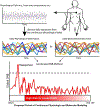Real-time, personalized medicine through wearable sensors and dynamic predictive modeling: a new paradigm for clinical medicine
- PMID: 32984661
- PMCID: PMC7515448
- DOI: 10.1016/j.coisb.2020.07.001
Real-time, personalized medicine through wearable sensors and dynamic predictive modeling: a new paradigm for clinical medicine
Abstract
Accurately predicting the onset and course of a disease in an individual is a major unmet challenge in medicine due to the complex and dynamic nature of disease progression. Continuous data from wearable technologies and biomarker data with a fine time resolution provide a unique opportunity to learn more about disease evolution and to usher in a new era of personalized and real-time medicine. Herein, we propose the potential of real-time, continuously measured physiological data as a noninvasive biomarker approach for detecting disease transitions, using allogeneic hematopoietic stem cell transplant (HCT) patient care as an example. Additionally, we review a recent computational technique, the landscape dynamic network biomarker method, that uses biomarker data to identify transition states in disease progression and explore how to use it with both biomarker and physiological data for earlier detection of graft-versus-host disease specifically. Throughout, we argue that increased collaboration across multiple fields is essential to realizing the full potential of wearable and biomarker data in a new paradigm of personalized and real-time medicine.
Conflict of interest statement
Disclosure of Conflicts of Interest. The authors have no conflicts-of-interest to disclose. Declaration of interests The authors declare that they have no known competing financial interests or personal relationships that could have appeared to influence the work reported in this paper.
Figures




References
-
- Harrap SB, Zammit KS, Wong ZYH, Williams FM, Bahlo M, Tonkin AM, Anderson ST, Genome-wide linkage analysis of the acute coronary syndrome suggests a locus on chromosome 2, Arterioscler. Thromb. Vasc. Biol 22 (2002) 874–878. - PubMed
-
- Ozaki K, Ohnishi Y, lida A, Sekine A, Yamada R, Tsunoda T, Sato H, Sato H, Hori M, Nakamura Y, Tanaka T, Functional SNPs in the lymphotoxin-alpha gene that are associated with susceptibility to myocardial infarction, Nat. Genet 32 (2002) 650–654. - PubMed
-
- Yamada Y, Izawa H, Ichihara S, Takatsu F, Ishihara H, Hirayama H, Sone T, Tanaka M, Yokota M, Prediction of the risk of myocardial infarction from polymorphisms in candidate genes, N. Engl. J. Med 347 (2002) 1916–1923. - PubMed
-
- Bown MJ, Horsburgh T, Nicholson ML, Bell PRF, Sayers RD, Cytokines, their genetic polymorphisms, and outcome after abdominal aortic aneurysm repair, Eur. J. Vasc. Endovasc. Surg 28 (2004) 274–280. - PubMed
-
- Hakonarson H, Thorvaldsson S, Helgadottir A, Gudbjartsson D, Zink F, Andresdottir M, Manolescu A, Arnar DO, Andersen K, Sigurdsson A, Thorgeirsson G, Jonsson A, Agnarsson U, Bjornsdottir H, Gottskalksson G, Einarsson A, Gudmundsdottir H, Adalsteinsdottir AE, Gudmundsson K, Kristjansson K, Hardarson T, Kristinsson A, Topol EJ, Gulcher J, Kong A, Gurney M, Thorgeirsson G, Stefansson K, Effects of a 5-lipoxygenase-activating protein inhibitor on biomarkers associated with risk of myocardial infarction: a randomized trial, JAMA. 293 (2005) 2245–2256. - PubMed
Grants and funding
LinkOut - more resources
Full Text Sources
